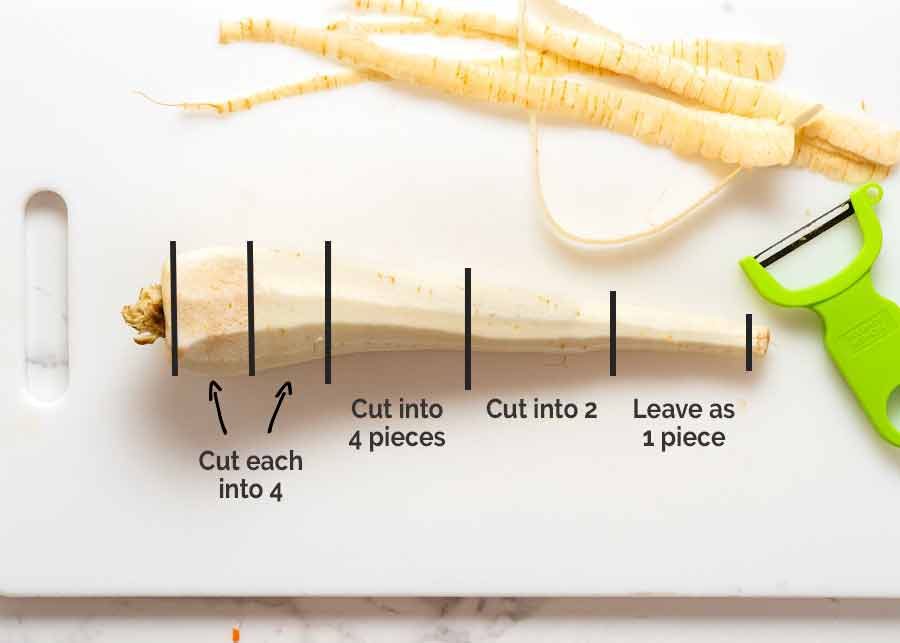Knowing how to make Roasted Vegetables well is a life essential! For the best results? Don’t mix root vegetables with high moisture vegetables like eggplant and zucchini. For the garlic, use smashed whole cloves instead of minced so it won’t burn. Finally, roast in a moderate rather than hot oven so the vegetables have time to sweeten and caramelise evenly!

Roasted Vegetables
I regard oven-roasted vegetables as a basic cooking skill everybody needs to master. It’s up there with cooking rice, making a soup, and whipping up a simple roast. It’s also a brilliant way to use up lots of vegetable odds and ends you might have lurking in the vegetable crisper at once.
Roasted vegetables is one of those recipes that readers have been asking for years but I kept shelving because I thought it just wasn’t exciting enough or so simple I didn’t have enough information to warrant writing about it. “Cut ’em, toss ’em in oil, salt and pepper, then throw ’em in the oven!” I’d tell friends who asked, with feigned sageness, because … how hard is that to do?
This would inevitably be followed up with a rapid series of questions: “But what temperature? Can I add flavours?? How big do I cut the vegetables??”
Upon which I would just pick up the phone and dictate to them the recipe I’ve written down below.
So, as it turns out, I do have information to impart about how to roast vegetables!
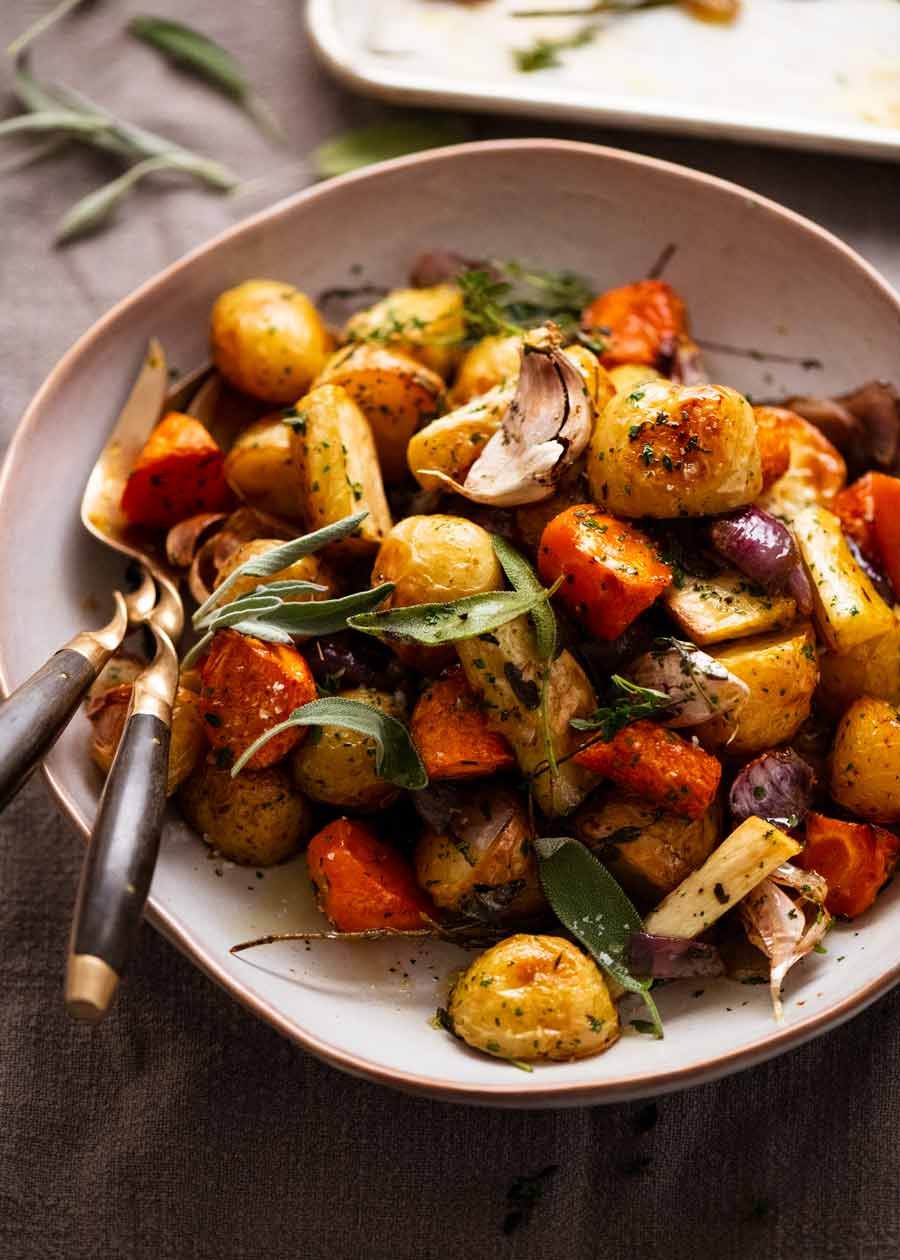
Vegetables I use
Here is a typical combination of vegetables I use when making a tray of roasted vegetables. I like this root vegetable medley one because there’s a nice mix of colour, texture and flavours. It’s also seasonal and economical, being winter here in Australia. Plus, other than the onion, the vegetables take the same length of time to roast in the oven which simplifies things.
See recipe notes for using other vegetables, including roasting time and how to cut.

-
Vegetables – (See below for how I cut each vegetable.) As mentioned at the beginning, this recipe will work for any roast-able vegetable. However, I recommend roasting starchy and hardier root vegetables separately from high moisture vegetables, such as eggplant.
It’s just easier because a) the roasting methods are quite different (high moisture vegetables do better with higher heat to rapidly caramelise and seal in the moisture); and b) nobody wants the watery insides of vegetables like eggplant bursting out and mixing with their potatoes!
-
Garlic – These are used whole, but SMASHED! This is when garlic is flattened with the skin on using the side of a knife so they burst open but largely stay in one piece. It imparts a lovely garlic flavour throughout the vegetables AND you get the treat of eating roasted garlic – so good!
As mentioned above, if you use minced garlic instead, you end up with lots of little bitter burnt bits of garlic throughout the vegetables. Not very nice!!
See below, or the recipe video, for a visual for how to smash garlic cloves.
-
Herbs – I’ve used fresh sage and thyme here which are two herbs that do well to impart subtle flavour when roasted. Other woody herbs like rosemary would also work well here.
More delicate herbs like oregano, chives, marjoram, basil etc, can’t withstand long oven cooking and will wilt and lose their flavour. Instead, sprinkle fresh over the vegetables once roasted.
Dried herbs option – Dried herbs will work just fine too, but they won’t add flavour in the same way fresh herbs do. To use dried herbs, just add when tossing with salt and pepper.
-
Parsley – This is just used as a garnish so it’s optional. Chives or chervil would also work nicely here.
How I cut vegetables to roast
Here are some diagrams illustrating how I cut vegetables for roasting. It doesn’t really matter what shape you cut them in as long as they are:
-
Same size – they are all roughly the same size so they roast in the same time; and
-
Large(ish) – they are not cut too small because bear in mind they shrink about 25% (nobody wants pea-size roasted veg!). We also want the vegetables to hold up in the oven for long enough so they caramelise nicely on the outside (small pieces = cooks faster on inside = not enough time for colour).
How I cut parsnip for roasting
For parsnip, I cut the thinner end differently from the thick end. Since it’s hard to make them exactly the same size, second best is to aim for batons / chunks that are roughly the same in weight so they cook in the same time.
How I cut carrots for roasting
I like to cut the carrots on alternating diagonals for a bit of visual interest and also because more surface area = more caramelisation = more flavour!
How I cut red onion for roasted vegetables
Cut the red onion into 2 – 2.5cm / 1″ squares. To do this, I cut the onion in half, then each half into 3 – 4 wedges (depending on size). Then I cut the wedges into 3 or 4 pieces.
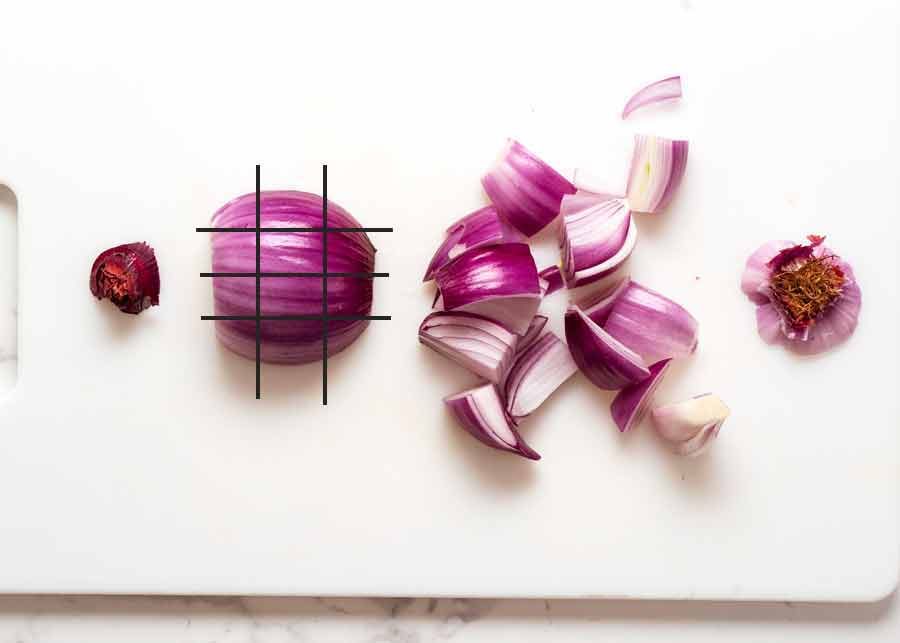
How I make roasted vegetables
To make roasted vegetables, I separate the onion and from rest of the vegetables because onions take less time in the oven.

-
Toss red onion with olive oil, salt and pepper in a separate bowl to the other vegetables, then set aside. We will add these onto the tray 30 minutes into the roasting time;
-
Remaining vegetables – Place the remaining vegetables in a separate bowl with the smashed garlic, thyme sprigs and hand torn sage (just tear the leaves off with hands, break sprigs in half). Toss it all with the oil, salt and pepper.
You will be surprised how much herb and garlic flavour is imparted to the roast vegetables using whole herbs/garlic instead of minced which you might be used to. As noted above, this works better because minced garlic/herbs just burns. Nobody wants bitter little bits of garlic littered throughout their sweet roasted vegetables … but everyone wants THIS ↓↓↓(“this” being sweet caramelised roasted garlic!).
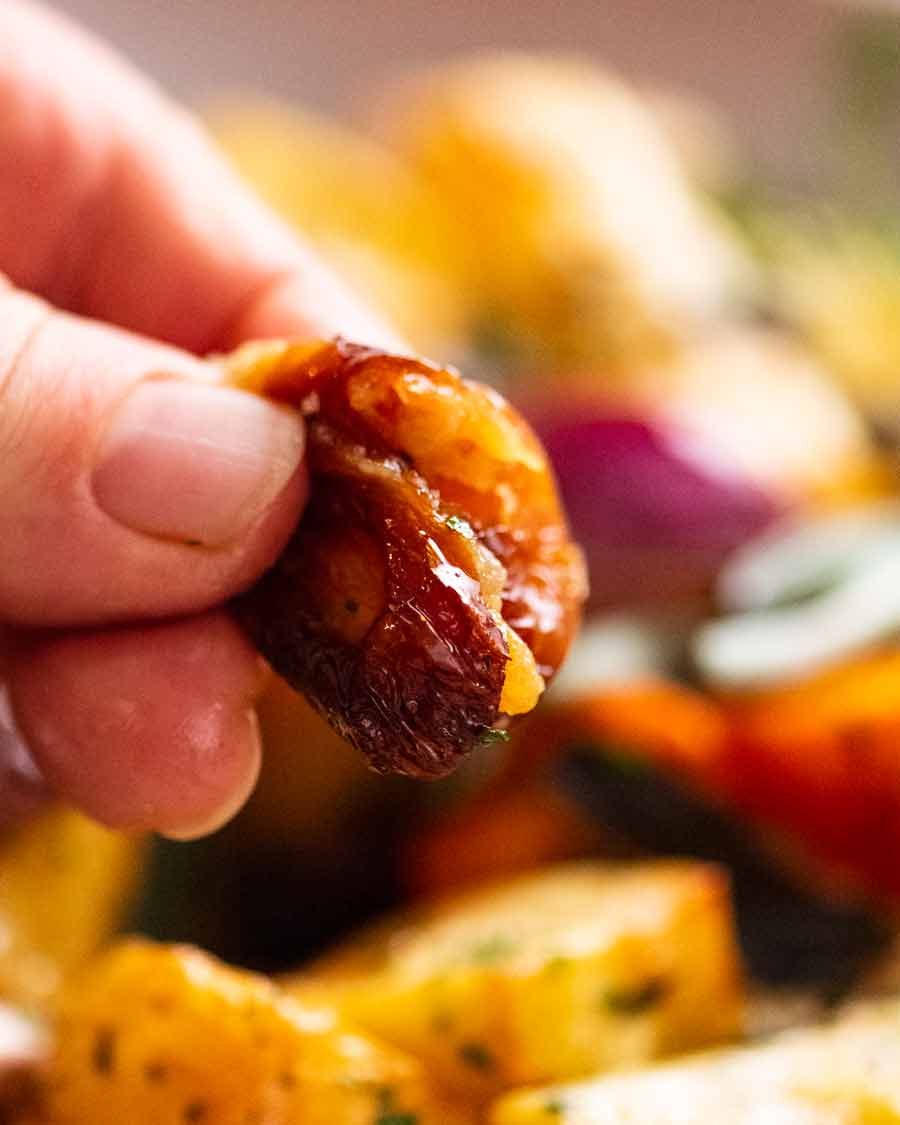
-
Oven 30 minutes – Spread the vegetables on a large roasting tray and roast for 30 minutes at 200°C/390°F (180°C fan). If you want to reduce clean up, line the tray with paper. But it’s not essential because we are using sufficient oil so the vegetables will not stick.
-
Add red onion – After 30 minutes, add red onion then give everything a quick toss.
-
Roast 60 minutes – Roast for a further 60 minutes, tossing halfway.
1 1/2 hours total roasting time might sound like a long time for roasted vegetables. But the longer roasting time at a slightly lower temperature than the hot ovens some recipes call for means the vegetables have time to sweeten which makes them all the more delicious!
-
Sprinkle with parsley if desired, then serve immediately!


I don’t think you need me to tell you what to serve roasted vegetables with. (Answer is – everything and anything!)
And while they are excellent as a side, don’t underestimate the deliciousness of a big bowl of roasted vegetables as a meal in itself (and a guilt-free one, no less.) It is literally what I just had for lunch not 1 hour ago! – Nagi x
Watch how to make it
Hungry for more? Subscribe to my newsletter and follow along on Facebook, Pinterest and Instagram for all of the latest updates.
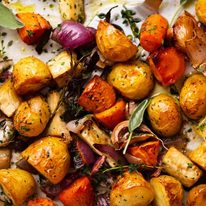
Roasted Vegetables
#wprm-recipe-rating-0 .wprm-rating-star.wprm-rating-star-full svg * { fill: #343434; }#wprm-recipe-rating-0 .wprm-rating-star.wprm-rating-star-33 svg * { fill: url(#wprm-recipe-rating-0-33); }#wprm-recipe-rating-0 .wprm-rating-star.wprm-rating-star-50 svg * { fill: url(#wprm-recipe-rating-0-50); }#wprm-recipe-rating-0 .wprm-rating-star.wprm-rating-star-66 svg * { fill: url(#wprm-recipe-rating-0-66); }linearGradient#wprm-recipe-rating-0-33 stop { stop-color: #343434; }linearGradient#wprm-recipe-rating-0-50 stop { stop-color: #343434; }linearGradient#wprm-recipe-rating-0-66 stop { stop-color: #343434; }
Ingredients
- 400g / 14oz small potatoes, skin on (10 or so)
- 2carrots, medium/large, peeled
- 1large parsnip(250g/8oz), peeled
- 1red onion, large, peeled (200g / 7oz)
- 5garlic cloves, smashed (Note 1)
- 5thyme sprigs
- 3sage sprigs
- 4tbspextra virgin olive oil
- 1tspcooking/kosher salt
- 1/4tspblack pepper
Garnish:
- 2tbspparsley, finely chopped
Instructions
Cutting vegetables:
-
Potatoes – Cut in half. (For large, cut into 3 or 4)
-
Carrots – Cut into 3cm / 1.2″ triangles on the diagonal (see diagram in post).
-
Parsnip – Cut into 4cm / 1.5″ lengths. Then cut into batons / chunks so they are roughly equal size (see diagram in post).
-
Red onion – Cut in half, then cut each half into 4 wedges. Then in cut into 3 or 4 so you get 2cm/ 0.8″ squares.
-
Smashed garlic – Place side of knife on unpeeled garlic clove. Hit firmly with palm of hand so the garlic bursts open a bit but mostly stays in tact.
Roasting:
-
Preheat oven to 200°C / 390°F (180°C fan).
-
Onion – Toss onion in one bowl with 1 tablespoon oil, and a pinch of the salt and pepper. Set aside – we add these later.
-
Other vegetables – Put all other vegetables, thyme and garlic in a separate bowl. Tear sage leaves and stems with hands, add into bowl. Toss with remaining oil, salt and pepper. Spread on a large baking tray.
-
Roasting – Roast 30 minutes. Add onion, toss vegetables. Roast for a further 1 hour, tossing halfway, until cooked through with golden edges.
-
Garnish & serve – Sprinkle with parsley and serve immediately!
Recipe Notes:
More delicate herbs like oregano, chives, marjoram, basil etc, can’t withstand oven cooking. Instead, sprinkle over the vegetables once roasted.
Dried herbs option – Dried herbs will work just fine too, but they won’t add flavour in the same way fresh herbs do. To use dried herbs, just add when tossing with salt and pepper.3. Other vegetables – Of course, other vegetables work! But I do recommend roasting starchy / root / hard veg (potatoes, carrot, parsnip) separately from high moisture / soft vegetables (eggplant, zucchini, capsicum / bell peppers) because they call for different roasting times. Also, nobody wants juice accidentally bursting out from eggplant making their potatoes wet!Add hard veg at the beginning, softer veg later. Here are some guides.Other hard veg (same roasting time per recipe, cut into similar sizes)
- Sweet potato
- Turnip
- Swedes
Soft Veg – Roasting time required at temp in recipe (don’t crowd the pan else they just sweat instead of browning)
- Capsicum / bell peppers – 2.5cm / 1″ squares, 20 minutes
- Mushrooms (large) – halved, 40 minutes
- Pumpkin, squash – 4cm / 1.5″ cubes, 30 minutes
- Zucchini – 4cm / 1.5″ chunks, 25 minutes
- Eggplant – See this recipe for best method
- Jerusalem artichokes – halved, 40 minutes
- Fennel – 2cm / 1″ slices, 45 minutes
Nutrition Information:
Life of Dozer
He’s taken to eating MUD. Clearly I’m not feeding him enough!!


